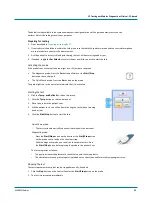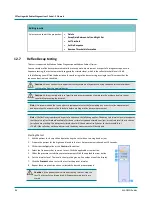
12 Testing with Zodiac Diagnostic or Clinical - PC-based
93
MADSEN Zodiac
The primary tympanogram is shown in this view.
C. Tympanogram
You can click the individual measurements in the data table to view and edit the corresponding deflection curves.
This table shows the settings and measurement results.
•
Probe tone in Hz
•
Stimulus side (Ipsi is the probe ear, and Contra is the opposite ear)
•
Stimulus frequency
•
Threshold level, if determined, or No Response, if determined
If a specific threshold has not been determined, the measurement is indicated by a marker
D. Threshold data table
B. Live baseline graph
The live baseline graph is an online admittance indicator which automatically monitors the admittance of the ear when
the probe is inserted.
Before you start a measurement, make sure that this baseline is as stable as possible. Fluctuations in the baseline will
have a destructive influence on the reflex measurements
To achieve a stable baseline, there are several factors influencing the stability of the baseline:
Patient behavior
•
The patient is completely still so that noise from the probe cables is minimized.
•
The patient must not speak or move the jaws.
•
The patient must breathe calmly.
Physiological conditions
•
Variations that are in synchrony with the patient's pulse:
In some patients, superficial blood vessels may influence the measurement. Try to place the probe at a different
depth in the ear canal. If the patient in general is troubled by a pulsatile tinnitus, this may indicate that further
consultation should be done to rule out a vascular middle-ear pathology.
•
Variations that are in synchrony with the patient's breathing:
This is a sign of Eustachian tube dysfunction and may prevent further reflex testing.
•
Variations due to a very steep tympanogram (for example seen in excessively flaccid tympanic membranes):
This problem can usually be remedied by slightly offsetting the air pressure from the tympanometric peak pressure
(TPP). In case of a negative TPP, it is recommended that the pressure is offset further in the negative direction. In
case of a positive TPP, it is recommended that the pressure is offset further in the positive direction.
An offset of approximately 20 daPa is usually sufficient to stabilize the baseline. Note that excessive offsets will
decrease the threshold sensitivity by several dB.
Use the pressure offset button
±P
to select a pressure offset to stabilize the eardrum. Keep the button depressed
and use the dial to select the desired pressure.
















































